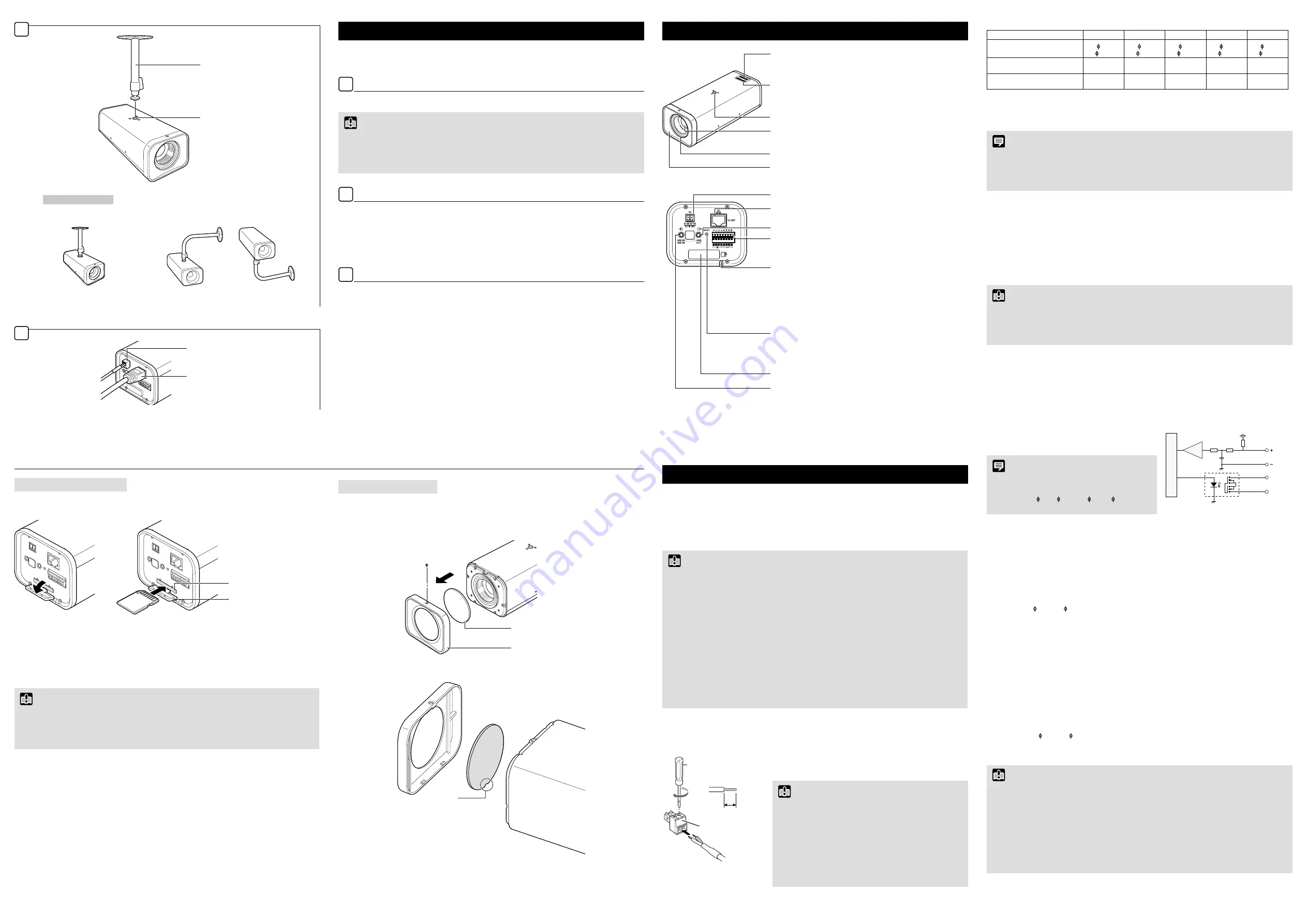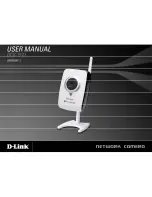
Part Names
MAC address
The camera's unique address. Write the address on the front of this
Installation Guide before installing the camera.
Serial number
The camera's serial number. Write the number on the front of this
Installation Guide before installing the camera.
Mounting screw holes
Lens
Protection plate
Front cover
Power connection terminal
100BT LAN connector
Audio output terminal (LINE OUT)
External Device I/O Terminals
LED
The blue LED light comes on.
• On: when powered on, during reboot, during normal use
• Off: when [
Turn Off
] is selected (see “Operation Guide” > “Setting
Page” > “Installation Conditions”)
* When [
Turn Off
] is selected, the LED light will come on for several seconds
when the camera is powered on and during reboot.
Reset Switch
Turn on the power while pushing this switch using a sharp object.
Continue to push the switch for 5 seconds or more to restore all
factory settings except for the date and time.
SD card cover
Audio input terminal (dual LINE IN and MIC IN)
Installing the Camera
Before installing the camera, set the IP address and other network information on the camera
using the “VB Initial Setting Tool” on the Setup CD-ROM.
For details on how to operate the “VB Initial Setting Tool”, see “Operation Guide”.
1
Mount the camera to the mounting bracket
Use the mounting screw holes on the camera to fix the camera to the mounting bracket.
Important
• You must consult your retailer or provide the mounting bracket yourself.
• A tripod mounting screw (1/4-20 UNC) will fit the fixing screw hole.
• Be sure to use a mounting bracket with a mounting screw shorter than 5.5 mm (0.22 in.). Using a
mounting bracket with a mounting screw 5.5 mm (0.22 in.) or longer may damage the camera.
2
Connect the cables to the camera
Connect the LAN cable.
If AC Adapter PA-V17 (sold separately) or an external power supply is used, connect the
power connector to the camera.
Connect cables to the external device I/O terminals and audio input/output terminals as
necessary.
3
Set the camera angle
When installation is complete, use the Camera Angle Setting Tool to check the image on the
camera and manually adjust the camera angle. Zoom and focus can be adjusted with the
Camera Angle Setting Tool (see “Operation Guide” > “Camera Angle Setting Tool”).
1
2
Connecting the Camera
Power Connection
Power can be supplied to the camera in the three ways described below.
PoE (Power over Ethernet)
The camera supports PoE functions. Power can be supplied to the camera by using a LAN cable
to connect it to a PoE HUB that conforms to the IEEE 802.3af standard.
Important
• Check with your dealer for more information about PoE HUB and Midspan technology.
• Some PoE HUBs allow current limits for each port, but applying limits may interfere with performance. If
using this type of PoE HUB, do not limit the operating current.
• Some PoE HUBs have total consumption current limits for ports, which can interfere with performance
when multiple ports are in use. For more information, check the instruction guide for your PoE HUB.
• Use a category 5 or higher cable 100 m (328 ft.) or less in length for the LAN cable that connects the
camera and the PoE HUB.
• When the camera is connected to a switching HUB, changing the connection while the camera is
operating may cause the HUB learning function to interfere with communication. Do not change the
connection when the camera is operating.
• The camera can also be connected to an AC adapter (sold separately) while receiving power from
a PoE HUB. In such cases, the PoE power supply is given priority, and the camera does not use the
power supply from the AC adapter (sold separately). When the PoE power supply is disconnected,
power is supplied automatically from the AC adapter (sold separately). Midspan (a LAN cable power
supply device) is a device that, like a PoE HUB, supplies power to the camera via a LAN cable.
External Power Supply
12 V DC or 24 V AC input can be used.
Connect the included power connector as shown below.
Screwdriver
Tightening torque: 0.2 N·m
(1.77lbf·in.)(max.)
Strip
Approx. 4 to 6 mm
(0.16 to 0.24 in.)
Power connector
(included)
For 12 V DC and 24 V AC input, use a power supply insulated
from 100 V AC.
12 V DC can be connected in a non-polar configuration.
Important
• The power supply should be within the following voltage range.
• 24 V AC: Voltage fluctuation within ±10% of 24 V AC (50 Hz or
60 Hz ±0.5 Hz or less)
Current supply capacity of at least 1.0 A per camera
• 12 V DC: Voltage fluctuation within ±10% of 12 V DC
Current supply capacity of at least 1.5 A per camera
• When using a 12 V DC battery power supply, be sure to connect
resistors of at least 0.5 - 1.0
Ω
/20 W in series to the power line.
• For an external power supply, use a double-insulated device.
Recommended Power Cables [Reference]
Cable (AWG)
24
22
20
18
16
Conductor diameter
mm
(in.)
0.52
( 0.020)
0.65
( 0.026)
0.82
( 0.032)
1.03
( 0.041)
1.30
( 0.051)
12 V DC maximum cable length m
(ft.)
5
(16.4)
9
(29.5)
14
(45.9)
23
(75.5)
32
(105.0)
24 V AC maximum cable length m
(ft.)
11
(36.1)
18
(59.1)
29
(95.1)
46
(150.9)
64
(210.0)
Use UL cable (UL-1015 or equivalent) for 12 V DC or 24 V AC wiring.
AC Adapter
Use the dedicated AC Adapter PA-V17 (sold separately).
Note
• The camera does not have a power switch. Connecting and disconnecting the LAN cable (PoE power
supply), AC adapter, or external power supply plug turns the power ON and OFF, respectively.
• When the camera needs to be rebooted, perform the reboot operation from the camera setting page
(see “Operation Guide” > “Setting Page” > “Maintenance”).
External Device I/O Terminals
External device I/O terminals consist of two input and output systems each. Viewer can be used
to check external device input status and control output to an external device (see “Operation
Guide” > “Operating the External Device Output” and “Displaying Event Status”).
External Device Input Terminals (IN1, IN2)
External device input terminals consist of two sets (IN1, IN2) of two terminals, with the negative
terminals connected to the camera interior GND. Connecting cables to the positive and negative
terminals and opening or closing the circuit notifies the Viewer.
Important
• When connecting sensors and switches, connect terminals that are electrically isolated from the
respective power and GND.
• Do not push the external device I/O terminal button with too much force. Doing so may cause the button
to remain pushed-in.
External Device Output Terminals (OUT1, OUT2)
External device output terminals consist of two sets (OUT1, OUT2) of two terminals. The sets
have no polarity. Controls from the viewer can be used to open and close the circuit between the
terminals. Using optical couplers, the output terminals are isolated from the camera's internal
circuit.
Internal Connection Diagram
Inter
nal contr
oller
External device
Input terminal
IN1, IN2
Output terminal
OUT1, OUT2
+3.3 V
0.1 μF
10 k
Ω
10 k
Ω
1 k
Ω
External device
The load connected to the output terminals should be within the following rating range.
Rating between output terminals:
Maximum voltage 50 V DC
Continuous load current at or below 100 mA
On resistance: Max. 30
Ω
Note
Adaptive wiring for external device cables
Solid conductor AWG: No. 28 - 22
Conductor size: 0.32 - 0.65 mm ( 0.013 - 0.026 in.)
Cable strip should be approx. 8 - 9 mm (0.31 - 0.35 in.)
Audio Input/Output Terminals
Each audio input/output terminal has one input system and one output system.
Connecting the camera to an audio input/output device such as a microphone or a speaker with
an amplifier allows you to send/receive audio through the viewer.
Audio Input Dual LINE IN/MIC IN (monaural input)
Although the camera has a single audio input system, it supports two types of microphone input:
LINE IN and MIC IN. Before using the audio input, change the [Audio Input] on the Setting Page
(see “Operation Guide” > “Audio Input”). LINE IN is selected by default.
Input terminal: 3.5 mm ( 0.14 in.) mini-jack (monaural)
• Dynamic MIC IN
Input impedance: 1.75 k
Ω
±20%
* Supported microphones: Output impedance: 400
Ω
- 600
Ω
• Condenser MIC IN
Input impedance (microphone bias resistance): 2.2 k
Ω
±20%
Microphone power supply: plug-in power (voltage: 1.8 V)
* Supported microphones: Condenser microphones with plug-in power support
• LINE IN
Input level: Max. 1 Vp-p
* Use a microphone with an amplifier.
Audio Output Terminal LINE OUT (monaural output)
Connect the camera to a speaker with an amplifier. Audio can be sent to the speaker from Viewer.
Output terminal: 3.5 mm ( 0.14 in.) mini-jack (monaural)
Output level: Max. 1 Vp-p
* Use a speaker with an amplifier.
Important
• Using incorrect settings for [Audio Input] may damage the camera and/or microphone. Be sure to
configure the settings correctly.
• Microphone characteristics may affect volume and sound quality.
• Images and audio do not always synchronize properly.
• Audio may be interrupted depending on PC characteristics and network environment.
• Images and audio can be streamed to up to 30 clients. However, audio may be interrupted when
streaming to many clients or using SSL.
• Audio may be interrupted when using antivirus software.
• Connecting and disconnecting the LAN cable interrupts the audio. Use the viewer to reconnect.
Using an SD Memory Card
Open the SD card cover as shown in the diagram to insert or remove the SD memory card.
Firmly shut the SD card cover after inserting or removing the SD memory card.
SD card slot
SD card cover
Inserting the card
Push the SD memory card as far as possible into the SD card slot.
Removing the card
Push the SD memory card in all the way until the card slightly pops out. Pinch the card and
remove.
Important
• Insert the SD memory card before installing the camera.
• Make sure the SD memory card is not write-protected.
• When using an SD memory card with the camera for the first time, it is recommended to format the card
after inserting it into the camera (see “Operation Guide” > “Setting Page” > “Memory Card”).
Mounting bracket
Using Camera Housing
When using the camera mounted in commercial camera housing, remove the camera's protection
plate to reduce the effects of excess reflections within the housing.
• Remove the lock screw on the front cover and remove the front cover and protection plate. Then
return only the front cover to its original position and fix in place with the lock screw.
Protection plate
Front cover
Lock screw
• When reattaching the protection plate, face the side with the cutout toward the lens.
Cutout
Mounting screw holes
Power connector
LAN cable
Example installations
Using a ceiling mounting bracket
Using a wall mounting bracket




















